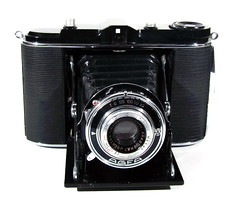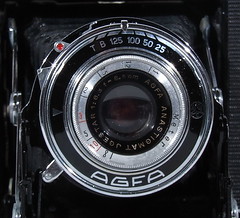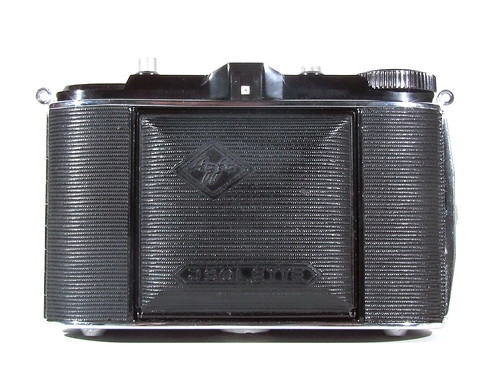Difference between revisions of "Isolette"
(Added the Isolette V, re-jigged the arrangement of pictures a bit.) |
m (Noted 'T' shutter control, in picture caption) |
||
| Line 105: | Line 105: | ||
|image= http://farm4.static.flickr.com/3272/3061172185_05c7ecaa27.jpg | |image= http://farm4.static.flickr.com/3272/3061172185_05c7ecaa27.jpg | ||
|image_align= | |image_align= | ||
| − | |image_text= Isolette V, with f/4.5 Agnar and Vario shutter. | + | |image_text= Isolette V, with f/4.5 Agnar and Vario shutter. The upright metal strip at the side of<br/>the shutter is the release. Note the control added to offer 'T' as well as 'B' shutter. |
|image_by= Raúl Sá Dantas | |image_by= Raúl Sá Dantas | ||
|image_rights= with permission | |image_rights= with permission | ||
Revision as of 21:16, 31 October 2011
The Isolette (embossed in the leatherette as JSOLETTE)[1] is a horizontal-folding camera for twelve 6×6 cm (2¼-inch square) pictures (or sixteen 4.5×6 cm (2¼×1⅝ inch) pictures, with the first model of the camera) on 120 film. It was made by Agfa Kamerawerk AG, Munich, Germany, from 1938.[2]
It first came on the market as the Isorette (again, appearing as JSORETTE on the camera), but the name was changed to Isolette within a year.
There are two distinct models of the first Isolette series: the early one (before and during the Second World War) and the post-War one.
Contents
Isolette (1938-42)
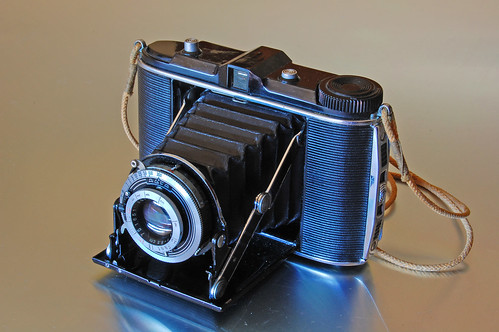
|
| First model Isolette. image by Raúl Sá Dantas (Image rights) |
This first model was a dual format camera: by using 2 internal masks it could be changed from the 6x6cm format to the 4.5x6cm format. There is also a mask for the viewfinder.
One of the distinctive features is the top housing made of a plastic called "Trolitan"; the post-War camera has a cast aluminium top housing. This camera also has loops to attach a strap, the only version of the Isolette to have these. Different lens and shutter combinations were available, allowing a wide range of levels of specification. All have front-element focusing. The shutter release is on the body. This model was called the "Soldatenkamera" (soldier's camera) in Germany during the War.
- Year of release: 1938[2]
- Film Format: 12 exp. 6x6 or 16 exp. 4.5x6 on 120 type rollfilm.
- Shutter: Vario, Pronto, Prontor II, Compur or Compur-Rapid.
- Lens: Igestar 8.5cm f/6.3, Apotar 8.5cm f/4.5 or Solinar 8.5cm f/4.5.
- Viewfinder: reverse-Galilean viewfinder
The earliest cameras have Vario shutters which are not labelled as such.
|
|
| ||||||
| Isolette, first model, about 1938.
Images by Süleyman Demir (Image rights) | ||||||||
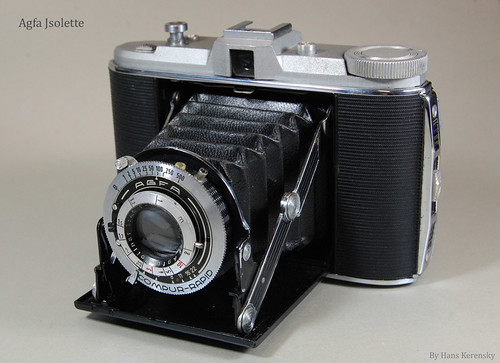
|
| Post-War Isolette image by Hans Kerensky (Image rights) |
Isolette (1945-50)
The first post-War model was made from 1945 till 1950. It is not adjustable to 4.5×6 cm format. The top housing of this model is cast from Hydronalium (Nüral: an aluminium alloy). There were less lens and shutter combinations, offering only the higher levels of specification (no Agnar, nor Vario or Pronto shutters). Most of the lenses are still uncoated.[2] Some of the shutters available are synchronised. The camera has an accessory shoe (above the viewfinder).
- Year of release: 1945
- Film Format: 12 exp. 6x6 on 120 film.
- Shutter: Prontor, Prontor-S or Compur-Rapid.
- Lens: Apotar 8.5cm f/4.5 or Solinar 8.5cm f/4.5.
- Double exposure prevention.
- Viewfinder: reverse-Galilean viewfinder

|
| Isolette V, with f/4.5 Agnar and Vario shutter. The upright metal strip at the side of the shutter is the release. Note the control added to offer 'T' as well as 'B' shutter. image by Raúl Sá Dantas (Image rights) |
Isolette V (1950-52)
The Isolette V has Agfa's entry-level f/4.5 Agnar triplet lens, and only low-specification shutters (Pronto or Vario). However, the lens is now coated on many examples, and the shutters are synchronised, with a PC socket. The accessory shoe is either on top of the viewfinder or to one side of it (on earlier examples). There is no body-mounted shutter release.
Succeeding models
After 1950, several different models of the Isolette were made at the same time, with different levels of specification:
- the Isolette I
- the Isolette II
- the Isolette III
- the Super Isolette
- the Isolette L
Notes
- ↑ The name is written as Jsolette simply because the capital "I" resembles a "J" in German typography of the time. The embossing on the camera was changed to a modern "I" in 1937. See: Old German Letters
- ↑ 2.0 2.1 2.2 McKeown, James M. and Joan C. McKeown's Price Guide to Antique and Classic Cameras, 12th Edition, 2005-2006. USA, Centennial Photo Service, 2004. ISBN 0-931838-40-1 (hardcover). ISBN 0-931838-41-X (softcover). p25.
